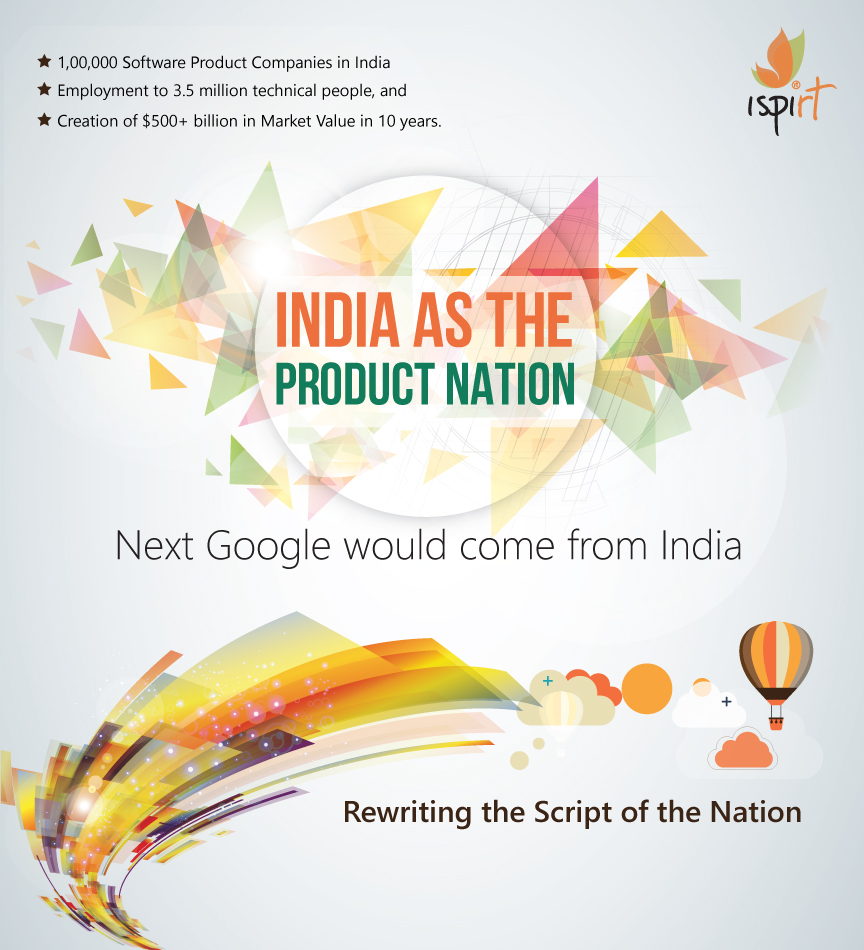The Next Google, Made in India
If you look at the Indian business landscape, you will see several successful services companies in fields like airlines (e.g. Jet, Indigo), health care (e.g. Apollo, Manipal), mobile phone services (e.g. Idea, Airtel) and IT Services (e.g. TCS, Infosys). Many of these companies are comparable to global peers, if not potential world beaters. What we don’t have are the corresponding product companies. We don’t have an aircraft maker like Boeing, a pharma company like Pfizer, a network equipment company like Cisco, or a software product company like Microsoft.
Is this is a problem? Yes. Because Boeing and Airbus alone generate almost as much profit as all global airlines put together. Pfizer’s profits are more than the profits of top 100 hospitals in US. Cisco’s profits are more than those of all European mobile operators. Microsoft generates more profit that the profits of top 20 pure-play global IT Services firms. Take a moment to digest that and it becomes clear that if India remains bereft of product companies, it won’t be a sustainable economy in the future.

Building product companies is hard, to be sure. Despite the fanfare, Tata Motors’ Nano has failed. And, sadly, Bajaj has been humbled by Honda in the last two years. In high-tech, Ittiam, despite its success in developing core intellectual property in online video, hasn’t broken into the main league. And, with our borders open to global competition, is it too far fetched to imagine that in a few years Amazon would have pipped Flipkart and Uber, not Ola, would rule our roads? We may have Indian players serving our digital consumers, but most categories might be dominated by foreign companies. Google already owns our search, Skype owns voice messaging, Facebook owns social media.
Is India destined to lose all these battles? Maybe not! But if we have to win, we have to embrace a new gameplan. Products, especially software products, are a winner-take-all business. Either you win or you are a nobody. Its not a place for the faint hearted.
In fact, tentativeness translates into a loss. It leads to sub-critical investments. We are staring at a costly example of this in the nuclear reactor industry right now. India can build 700 MW reactors. But economies of scale now kick-in at 1600 MW. Since we didn’t invest enough in the last 20 years (despite a wonderful start that Homi Bhabha gave us in 1950s), we are not a player in this large-reactor segment. So we will spend more on buying these bigger reactors from France, Russia and US in the next three years than what we have spent on our entire nuclear industry in the past 50 years! This is a really expensive failure.
If this was a one-off case it would still be okay. It is unfortunately not. In telecom, despite CDOT, CDAC and Sam Pitroda, we have only created one Tejas Networks, a nifty networking start-up from Bangalore. But, guess what? Tejas gets a pidly 1% of the annual telecom capex buys in the country. Rest is imported. We have a big rail network but no rail equipment companies. We are a generic drugs superpower but limp when it comes to new drug discoveries. These failures to create product winners don’t even faze us. We pretend it doesn’t matter.
We don’t even introspect why this is the case. When one sets out to create the world’s best hospital, airline or IT Services company, one builds in layers over years. But building a world class product company needs a different mindset. You have go all-in and bet-the-company on market or technology shift that is underway. This mindset is new to us in India. Our success in building services companies comes in the way. We have to accept this Provenance Effect; it is subtle yet significant.
To be sure, we are not the only victims of this effect. Taiwan is a victim of this too. It isn’t a player in mobile phones, ironically, because its design services legacy holds it back. Venezuela is not able to crack the chocolate market. El Ray owns the high end cocoa market, a key raw ingredient in chocolate, but comes up a cropper in high chocolates. If you ask the Belgians or Swiss, they tell you that they are a chocolate nation because they don’t have the cocoa mindset. Lack of a services industry legacy helps not just Korea but also Estonia (created Skype) and Finland (land of Nokia and Angry Bird games). It turns out that mindset matters — big time!
We have to jettison two ideas that hold us back from becoming a Product Nation! The first one is rather simple. We have to accept that no matter how well-run Indigo Airlines is it’ll not become a Embraer or Boeing. Similarly, a Narayana Hrudayalaya hospital will never bring a drug to market like a Pfizer does. Airtel or Verizon will never build a router like Cisco or Juniper do. And TCS will never be a Microsoft. Acknowledging this plain reality is the first step that we must take.
Then, we must discard our mentality of unbridled greed and reluctance to make bets — best showcased in our penchant for large Olympics contingents. Nobody cares about how many athletes you send to a sports competition, they only care about the number of medals you won. To improve odds of winning, small focussed efforts produce better results than grandiose schemes. Today, we have four times more new startups than Israel for one-sixth the outcomes. One reason is that the ecosystem enablers are narrowly sector focussed in Israel. The accelerators that help medical device companies don’t work with cyber-security start-ups there. Can’t we have a sector-focussed approach in India aiming at solar energy or medical devices, to name just two promising areas to bet on? If someone needs proof of concept: look at our performance in badminton and wrestling in India in recent years. The enablers in these sports are game-specific. Anything that smells like a generic “startup” program will have a low impact. It quite likely to be a scam!
Software product entrepreneurs when they are successful make a big economic impact in this winner-take-all world. So they are being courted worldwide. US is trying to get the Startup Visas in place for them. Canada already has a working program. Singapore has startup tax exemption. UK is in the game too. In our last budget there was a tantalizing line about “a special focus on software product startups”. Nine months have passed and nothing material has happened yet. Maybe this new budget will bring some well thought-out policies to light. This year 75% of newly funded software product startups will redomicile themselves in Singapore or US (up from 54% last year).
It is time for India to wake up to our Product Nation imperative. It is an opportunity for the NDA government to write history again. In 1998, they introduced a 108 point policy for IT services and we have the benefits around us to see. Now, they must do the same for software products. For the first time in modern India’s history, we have a chance to create world-winning products from India. The decisions we take today to support our flight to become a Product Nation will decide whether tomorrow’s Google, Viagra,Facebook, or Uber come from our nation. Act now.
Jointly written by Mohandas Pai & Sharad Sharma for Economic Times.








